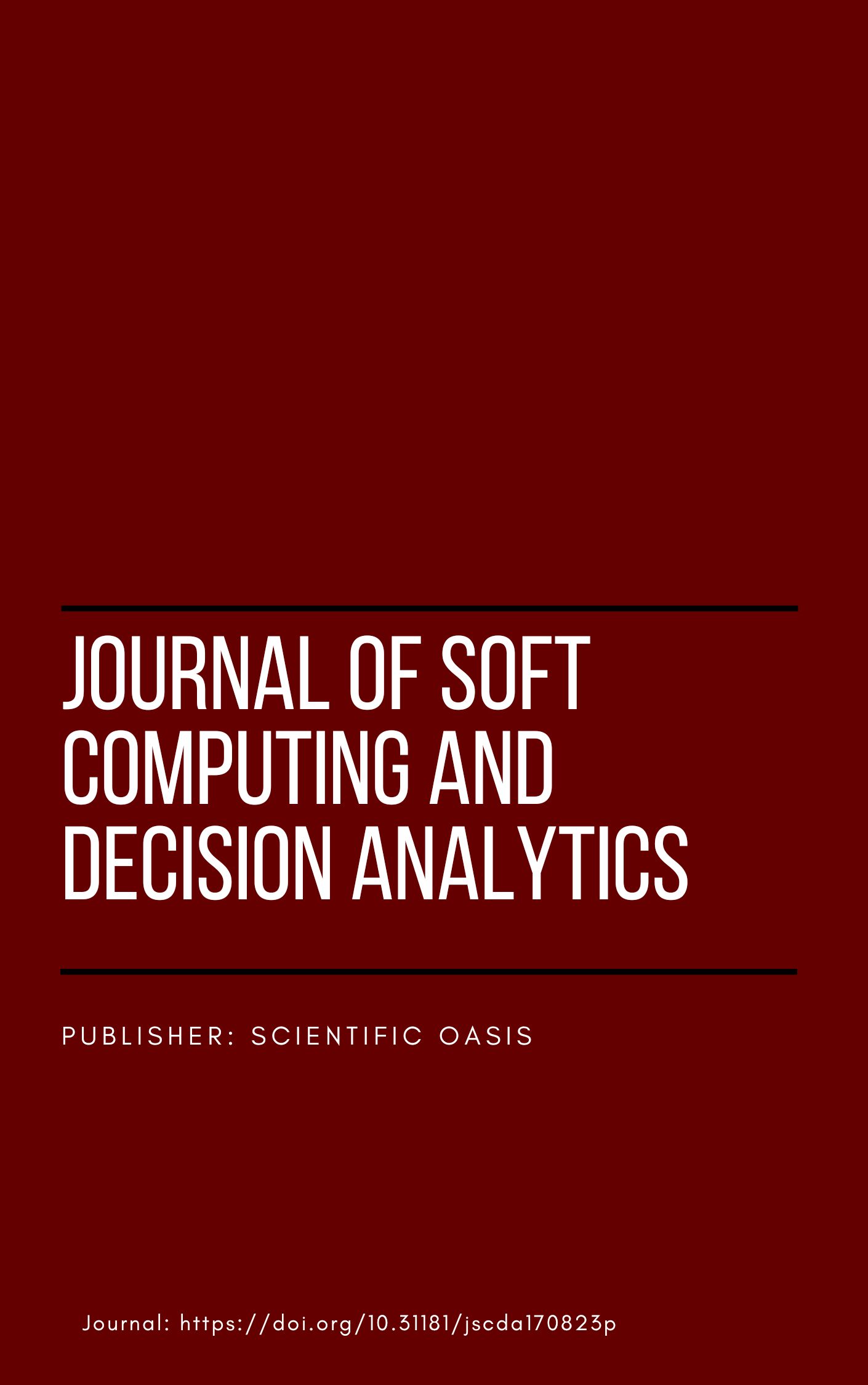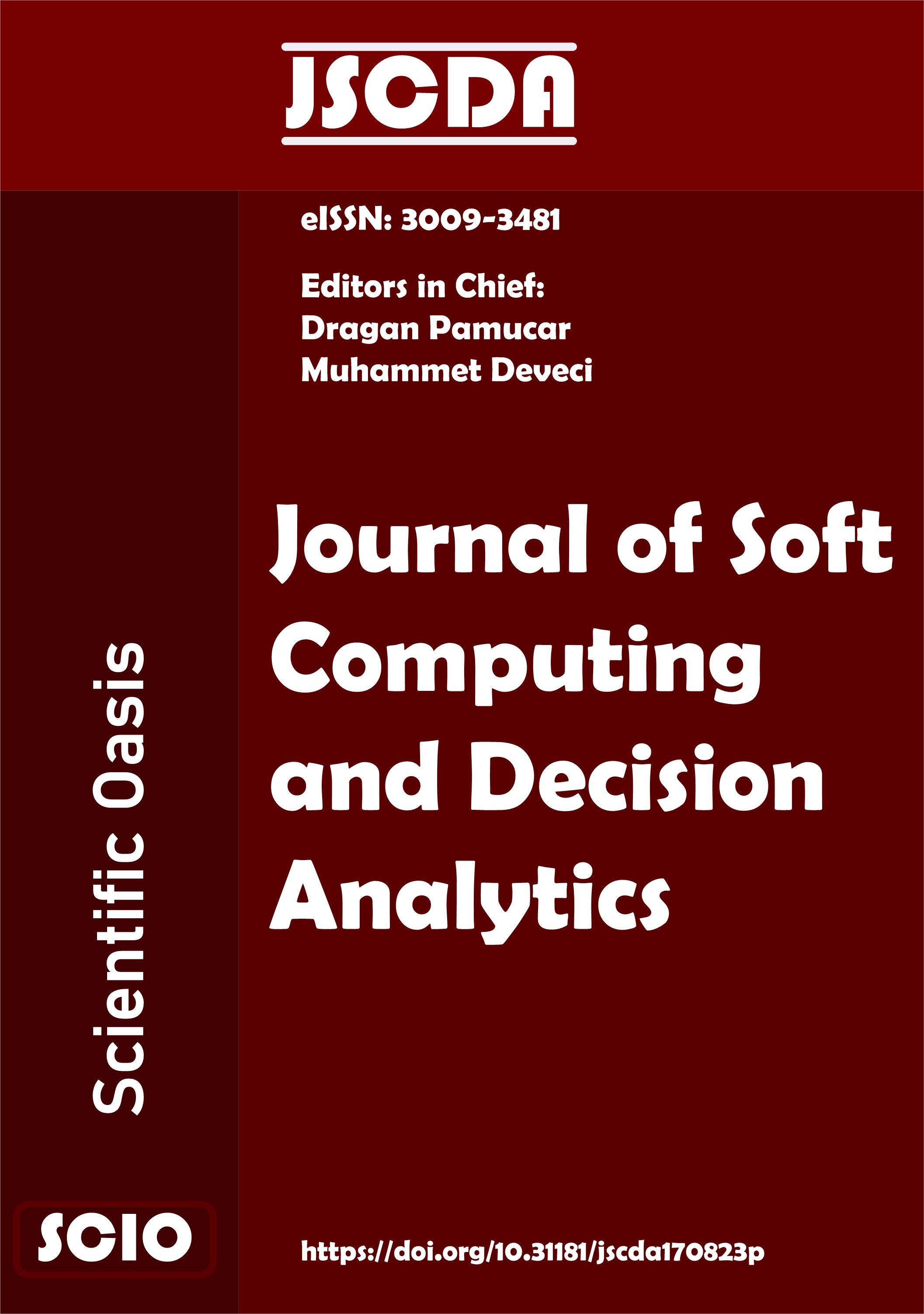Analysis Impact of Financial Ratios on Bank Success Using Machine Learning Classification Algorithms: The Case of Turkey
DOI:
https://doi.org/10.31181/jscda31202553Keywords:
Machine Learning Algorithms, Classification , Bank Success, Financial RatiosAbstract
In the competitive environment of the 21st century, making accurate and swift decisions is of great importance for the success of businesses. In the banking sector, which provides financial services and is critical to the economy, decision-making processes are considered a crucial step in enhancing bank performance, operational efficiency, and customer satisfaction. However, traditional methods that generally rely on past experiences and intuition are found to be inadequate for analysing large data sets. In this context, it is considered that the use of artificial intelligence in analysing large data sets will provide significant advantages by increasing the speed and accuracy of decision-making processes. Therefore, the effective use of large data sets, optimization of decision-making processes, and the use of artificial intelligence to increase bank success can be highlighted as important tools. In this study, the factors determining the success of banks operating in the Turkish banking sector and the factors that should be considered in decision-making processes for bank success were examined using machine learning methods. The study, which covers the period from 2012 to 2022 for 24 banks, classified 43 financial ratios into six groups: capital adequacy, profitability, liquidity, asset quality, balance sheet structure, and income-expenditure structure. Thus, the effects of factors determining bank success in the context of these main groups were analysed. Additionally, a comprehensive analysis using all 43 financial ratios was conducted to provide a general examination of the factors determining bank success. The study concluded that machine learning methods, with their high accuracy rates, can be effectively used in decision-making, monitoring, and auditing processes.
References
Assous, H. F. (2022). Prediction of banks efficiency using feature selection method: comparison between selected machine learning models. Complexity, 2022(1), 3374489. https://doi.org/10.1155/2022/3374489.
Ozgur, O., Karagol, E. T., & Ozbugday, F. C. (2021). Machine learning approach to drivers of bank lending: evidence from an emerging economy. Financial Innovation, 7, 1-29. https://doi.org/10.1186/s40854-021-00237-1.
Bonello, J., BrÉdart, X., & Vella, V. (2018). Machine learning models for predicting financial distress. Journal of Research in Economics, 2(2), 174-185. https://doi.org/10.24954/JORE.2018.22.
Halkos, G. E., & Salamouris, D. S. (2004). Efficiency measurement of the Greek commercial banks with the use of financial ratios: A data envelopment analysis approach. Management accounting research. 15(2), 201-224. https://doi.org/10.1016/j.mar.2004.02.001.
Wu, D. D., Yang, Z., & Liang, L. (2006). Using DEA-neural network approach to evaluate branch efficiency of a large Canadian bank. Expert systems with applications, 31(1), 108-115. https://doi.org/10.1016/j.eswa.2005.09.034.
Nur Ozkan‐Gunay, E., & Ozkan, M. (2007). Prediction of bank failures in emerging financial markets: an ANN approach. The Journal of Risk Finance, 8(5), 465-480. https://doi.org/10.1108/15265940710834753.
Leo, M., Sharma, S., & Maddulety, K. (2019). Machine learning in banking risk management: A literature review. Risks, 7(1), 29. https://doi.org/10.3390/risks7010029.
Malali, A. B., & Gopalakrishnan, S. (2020). Application of artificial intelligence and its powered technologies in the Indian banking and financial industry: An overview. IOSR Journal of Humanities and Social Science, 25(4), 55-60.
Königstorfer, F., & Thalmann, S. (2020). Applications of Artificial Intelligence in commercial banks–A research agenda for behavioral finance. Journal of behavioral and experimental finance, 27, 100352. https://doi.org/10.1016/j.jbef.2020.100352.
Appiahene, P., Missah, Y. M., & Najim, U. (2020). Predicting bank operational efficiency using machine learning algorithm: comparative study of decision tree, random forest, and neural networks. Advances in fuzzy systems, 2020(1), 8581202. https://doi.org/10.1155/2020/8581202.
Fares, O. H., Butt, I., & Lee, S. H. M. (2023). Utilization of artificial intelligence in the banking sector: A systematic literature review. Journal of Financial Services Marketing, 28(4), 835-852. https://doi.org/10.1057/s41264-022-00176-7.
Umamaheswari, S., & Valarmathi, A. (2023). Role of artificial intelligence in the banking sector. Journal of Survey in Fisheries Sciences, 10(4S), 2841-2849. https://doi.org/10.17762/sfs.v10i4S.1722.
Doumpos, M., Zopounidis, C., Gounopoulos, D., Platanakis, E., & Zhang, W. (2023). Operational research and artificial intelligence methods in banking. European Journal of Operational Research, 306(1), 1-16. https://doi.org/10.1016/j.ejor.2022.04.027.
Gangwani, D., & Zhu, X. (2024). Modeling and prediction of business success: a survey. Artificial Intelligence Review 57(44), 1-51. https://doi.org/10.1007/s10462-023-10664-4.
Russell, S. J., & Norvig, P. (2016). Artificial intelligence: a modern approach. Pearson.
Michalski, R. S., Carbonell, J. G., & Mitchell, T. M. (Eds.). (2013). Machine learning: An artificial intelligence approach. Springer Science & Business Media.
Davenport, T. H., & Ronanki, R. (2018). Artificial intelligence for the real world. Harvard business review, 96(1), 108-116.
Makridakis, S. (2017). The forthcoming Artificial Intelligence (AI) revolution: Its impact on society and firms. Futures, 90, 46-60. https://doi.org/10.1016/j.futures.2017.03.006.
Javaid, M., Haleem, A., Singh, R. P., Rab, S., & Suman, R. (2022). Exploring impact and features of machine vision for progressive industry 4.0 culture. Sensors International, 3, 100132. https://doi.org/10.1016/j.sintl.2021.100132.
Brynjolfsson, E., & McAfee, A. (2014). The second machine age: Work, progress, and prosperity in a time of brilliant technologies. WW Norton & Company.
Davenport, T., & Harris, J. (2017). Competing on analytics: Updated, with a new introduction: The new science of winning. Harvard Business Press.
Li, C. (2010). Groundswell. Winning in a world transformed by social technologies. Strategic Direction, 26(8), 136138. https://doi.org/10.1108/sd.2010.05626hae.002.
Porter, M. E., & Heppelmann, J. E. (2014). How smart, connected products are transforming competition. Harvard business review, 92(11), 64-88.
Shukla Shubhendu, S., & Vijay, J. (2013). Applicability of artificial intelligence in different fields of life. International Journal of Scientific Engineering and Research, 1(1), 28-35. https://doi.org/10.70729/1130915.
Duda, R. O., & Hart, P. E. (2006). Pattern classification. John Wiley & Sons.
Robu, R., & Holban, S. (2011, May). A genetic algorithm for classification. In Recent Researches in Computers and Computing-International Conference on Computers and Computing, ICCC (Vol. 11, No. 05).
Bao, J., Zheng, Y., Wilkie, D., & Mokbel, M. (2015). Recommendations in location-based social networks: a survey. GeoInformatica, 19, 525-565. https://doi.org/10.1007/s10707-014-0220-8.
Cummins, S., W. Peltier, J., A. Schibrowsky, J., & Nill, A. (2014). Consumer behavior in the online context. Journal of Research in Interactive Marketing, 8(3), 169-202. https://doi.org/10.1108/JRIM-04-2013-0019.
Jain, A. K. (2010). Data clustering: 50 years beyond K-means. Pattern recognition letters, 31(8), 651-666. https://doi.org/10.1016/j.patrec.2009.09.011.
Maulud, D., & Abdulazeez, A. M. (2020). A review on linear regression comprehensive in machine learning. Journal of Applied Science and Technology Trends, 1(2), 140-147.
Theissler, A., Spinnato, F., Schlegel, U., & Guidotti, R. (2022). Explainable AI for time series classification: a review, taxonomy and research directions. IEEE Access, 10, 100700-100724. https://doi.org/10.1109/ACCESS.2022.3207765
Nocedal, J., & Wright, S. J. (1999). Numerical optimization. New York: NY: Springer New York.
Hosmer Jr, D. W., Lemeshow, S., & Sturdivant, R. X. (2013). Applied logistic regression. John Wiley & Sons.
Hellevik, O. (2009). Linear versus logistic regression when the dependent variable is a dichotomy. Quality & Quantity, 43, 59-74. https://doi.org/10.1007/s11135-007-9077-3.
Dhanabal, S., & Chandramathi, S. (2011). A review of various k-nearest neighbor query processing techniques. International Journal of Computer Applications, 31(7), 14-22. https://doi.org/10.5120/3836-5332.
Mucherino, A., Papajorgji, P. J., Pardalos, P. M., Mucherino, A., Papajorgji, P. J., & Pardalos, P. M. (2009). K-nearest neighbor classification. Data mining in agriculture, 83-106. https://doi.org/10.1007/978-0-387-88615-2_4.
Cristianini, N., & Shawe-Taylor, J. (2000). An introduction to support vector machines and other kernel-based learning methods. Cambridge university press.
LeCun, Y., Bengio, Y., & Hinton, G. (2015). Deep learning. Nature, 521(7553), 436-444. http://dx.doi.org/10.1038/nature14539.
Schmidhuber, J. (2015). Deep learning in neural networks: An overview. Neural networks, 61, 85-117. https://doi.org/10.48550/arXiv.1404.7828.
Shu, X., & Ye, Y. (2023). Knowledge Discovery: Methods from data mining and machine learning. Social Science Research, 110, 102817. https://doi.org/10.1016/j.ssresearch.2022.102817.
Hastie, T., Tibshirani, R., Friedman, J. H., & Friedman, J. H. (2009). The elements of statistical learning: data mining, inference, and prediction (Vol. 2, pp. 1-758). New York: springer.
Breiman, L. (2017). Classification and regression trees. Routledge.
Zounemat-Kermani, M., Batelaan, O., Fadaee, M., & Hinkelmann, R. (2021). Ensemble machine learning paradigms in hydrology: A review. Journal of Hydrology, 598, 126266. https://doi.org/10.1016/j.jhydrol.2021.126266.
Ali, J., Khan, R., Ahmad, N., & Maqsood, I. (2012). Random forests and decision trees. International Journal of Computer Science Issues (IJCSI), 9(5), 272.
Liaw, A., & Wiener, M. (2002). Classification and regression by Random Forest. R news, 2(3), 18-22.
Friedman, J. H. (2001). Greedy function approximation: a gradient boosting machine. Annals of statistics, 1189-1232.
Feng, Z., Xu, C., & Tao, D. (2018, September). Historical Gradient Boosting Machine. In GCAI (pp. 68-80).
Natekin, A., & Knoll, A. (2013). Gradient boosting machines, a tutorial. Frontiers in Neurorobotics, 7, 1-21. https://doi.org/10.3389/fnbot.2013.00021.
Chen, T., & Guestrin, C. (2016, August). Xgboost: A scalable tree boosting system. In Proceedings of the 22nd acm sigkdd international conference on knowledge discovery and data mining (pp. 785-794).
Ramraj, S., Uzir, N., Sunil, R., & Banerjee, S. (2016). Experimenting XGBoost algorithm for prediction and classification of different datasets. International Journal of Control Theory and Applications, 9(40), 651-662.
Ke, G., Meng, Q., Finley, T., Wang, T., Chen, W., Ma, W., ... & Liu, T. Y. (2017). Lightgbm: A highly efficient gradient boosting decision tree. Advances in neural information processing systems, 30.
Wang, D. N., Li, L., & Zhao, D. (2022). Corporate finance risk prediction based on LightGBM. Information Sciences, 602, 259-268. https://doi.org/10.1016/j.ins.2022.04.058.
Prokhorenkova, L., Gusev, G., Vorobev, A., Dorogush, A. V., & Gulin, A. (2018). CatBoost: unbiased boosting with categorical features. Advances in neural information processing systems, 31, 1-23. https://doi.org/10.48550/arXiv.1706.09516.
Dorogush, A. V., Ershov, V., & Gulin, A. (2018). CatBoost: gradient boosting with categorical features support. arXiv preprint arXiv:1810.11363.
Albulescu, C. T. (2015). Banks’ profitability and financial soundness indicators: A macro-level investigation in emerging countries.Procedia economics and finance,23,203-209.https://doi.org/10.1016/S2212-5671(15)00551-1.
Sagita, B., & Nugraha, N. (2022, July). Does Liquidity or Profitability Influence Firm Financial Distress Most? Empirical Study on Manufacturing Companies Listed in Indonesia Stock Exchange (2015-2019). In 6th Global Conference on Business, Management, and Entrepreneurship (GCBME 2021) (pp. 51-56). Atlantis Press.
Aupperle, K. E., & Sarhan, M. H. (1995). Assessing financial performance in the capstone, strategic management course: A proposed template. Journal of Education for Business, 71(2), 72-77. https://doi.org/10.1177/2379298120909513.
Downloads
Published
Issue
Section
License
Copyright (c) 2025 Scientific Oasis

This work is licensed under a Creative Commons Attribution-NonCommercial-NoDerivatives 4.0 International License.
















